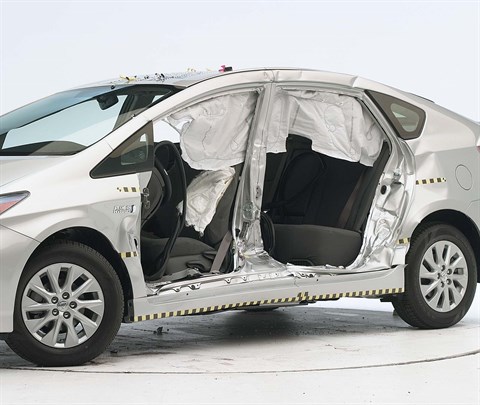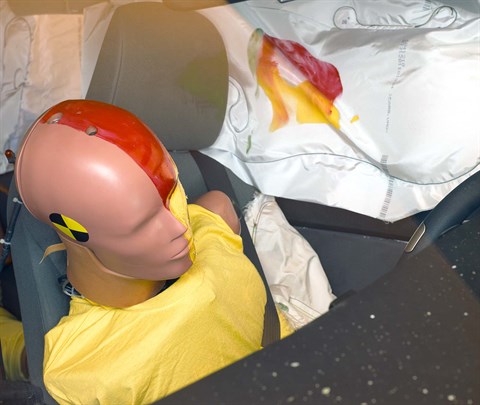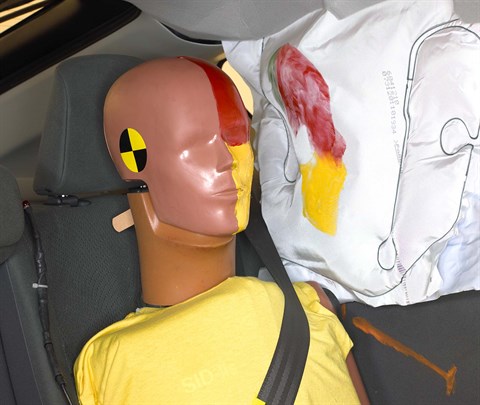Moderate overlap front: original test
Rating applies to 2010-15 models
Tested vehicle: 2010 Toyota Prius 4-door
The Toyota Prius was redesigned for the 2010 model year. As in earlier models, the Prius is a hybrid with both a gasoline engine and electric motor. A Prius Plug-in model was introduced in the 2012 model year. This variant also uses a gasoline engine and electric motor, but the motor's lithium-ion battery can be charged by connecting it with an electrical cord to a standard household outlet. The Plug-in is designed to operate primarily in electric mode for 11 miles from a full charge. Beyond this range, it operates in the same manner as the standard Prius.
Two tests of the Prius were conducted, the first by Toyota of a 2010 Prius and the second by the Institute of a 2012 Prius Plug-in. Ratings are based on both tests and apply to both Prius variants. Vehicle specifications are provided for the 2010 Prius from the Toyota test and photos are provided from the Institute's test of the 2012 Prius Plug-in.
| Evaluation criteria | Rating |
|---|---|
| Overall evaluation | |
| Structure and safety cage | |
| Driver injury measures | |
| Head/neck | |
| Chest | |
| Leg/foot, left | |
| Leg/foot, right | |
| Driver restraints and dummy kinematics | |

Action shot taken during the Institute's moderate offset frontal crash test.

The dummy's position in relation to the steering wheel and instrument panel after the crash test indicates that the driver's survival space was maintained very well (Institute test car shown).

Dummy movement was well controlled in both tests. During rebound in the Institute's test, the dummy's head hit the roof rail, as indicated by smeared greasepaint.

In both tests, intrusion into the driver's space was minimal, and all leg and foot injury measures were low (the yellow strip is marking tape that came off the instrument panel during the Institute's test).
Measures of occupant compartment intrusion on driver side
| Evaluation criteria | Measurement | |
|---|---|---|
| Test ID | VTF0901 | CEF1205 |
| Footwell intrusion | ||
| Footrest (cm) | 2 | 6 |
| Left (cm) | 8 | 9 |
| Center (cm) | 12 | 17 |
| Right (cm) | 4 | 9 |
| Brake pedal (cm) | 3 | 6 |
| Instrument panel rearward movement | ||
| Left (cm) | 3 | 4 |
| Right (cm) | 3 | 3 |
| Steering column movement | ||
| Upward (cm) | -2 | -3 |
| Rearward (cm) | 3 | 0 |
| A-pillar rearward movement (cm) | 2 | 2 |
Driver injury measures
| Evaluation criteria | Measurement | |
|---|---|---|
| Test ID | VTF0901 | CEF1205 |
| Head | ||
| HIC-15 | 443 | 250 |
| Peak gs at hard contact | 84 | 65 |
| Neck | ||
| Tension (kN) | 1.5 | 0.9 |
| Extension bending moment (Nm) | 16 | 38 |
| Maximum Nij | 0.29 | 0.35 |
| Chest maximum compression (mm) | 29 | 27 |
| Legs | ||
| Femur force - left (kN) | 1.5 | 1.0 |
| Femur force - right (kN) | 1.3 | 1.1 |
| Knee displacement - left (mm) | 1 | 1 |
| Knee displacement - right (mm) | 1 | 0 |
| Maximum tibia index - left | 0.47 | 0.38 |
| Maximum tibia index - right | 0.54 | 0.41 |
| Tibia axial force - left (kN) | 2.8 | 1.8 |
| Tibia axial force - right (kN) | 2.7 | 3.0 |
| Foot acceleration (g) | ||
| Left | 62 | 59 |
| Right | 53 | 68 |
Side: original test
Rating applies to 2010-15 models
Tested vehicle: 2010 Toyota Prius 4-door with standard front and rear head curtain airbags and standard front seat-mounted torso airbags
The Toyota Prius was redesigned for the 2010 model year. As in earlier models, the Prius is a hybrid with both a gasoline engine and electric motor. A Prius Plug-in model was introduced in the 2012 model year. This variant also uses a gasoline engine and electric motor, but the motor's lithium-ion battery can be charged by connecting it with an electrical cord to a standard household outlet. The Plug-in is designed to operate primarily in electric mode for 11 miles from a full charge. Beyond this range, it operates in the same manner as the standard Prius.
Two tests of the Prius were conducted, the first by Toyota of a 2010 Prius and the second by the Institute of a 2012 Prius Plug-in. Ratings are based on both tests and apply to both Prius variants. Vehicle specifications are provided for the 2010 Prius from the Toyota test and photos are provided from the Institute's test of the 2012 Prius Plug-in.
| Evaluation criteria | Rating |
|---|---|
| Overall evaluation | |
| Structure and safety cage | |
| Driver injury measures | |
| Head/neck | |
| Torso | |
| Pelvis/leg | |
| Driver head protection | |
| Rear passenger injury measures | |
| Head/neck | |
| Torso | |
| Pelvis/leg | |
| Rear passenger head protection | |

View of the vehicle and barrier just after the Institute's crash test.

View of the vehicle after the crash with doors removed, showing the side airbags and damage to the occupant compartment.

Smeared greasepaint shows where the driver dummy's head was protected from being hit by hard structures by the side curtain airbag in the Institute's test.

Smeared greasepaint shows where the rear passenger dummy’s head was protected by the side airbag.
Measures of occupant compartment intrusion on driver side
| Test ID | VTS0901 | CES1206 |
|---|---|---|
| B-pillar to longitudinal centerline of driver's seat (cm) | -11.0 | -11.5 |
| Negative numbers indicate the amount by which the crush stopped short of the seat centerline. | ||
Driver injury measures
| Evaluation criteria | Measurement | |
|---|---|---|
| Test ID | VTS0901 | CES1206 |
| Head HIC-15 | 562 | 391 |
| Neck | ||
| Tension (kN) | 1.0 | 0.7 |
| Compression (kN) | 0.1 | 0.1 |
| Shoulder | ||
| Lateral deflection (mm) | 52 | 56 |
| Lateral force (kN) | 1.9 | 2.1 |
| Torso | ||
| Maximum deflection (mm) | 36 | 36 |
| Average deflection (mm) | 27 | 23 |
| Maximum deflection rate (m/s) | 5.50 | 3.11 |
| Maximum viscous criterion (m/s) | 0.78 | 0.51 |
| Pelvis | ||
| Iliac force (kN) | 1.0 | 1.5 |
| Acetabulum force (kN) | 1.9 | 1.8 |
| Combined force (kN) | 2.6 | 3.1 |
| Left femur | ||
| L-M force (kN) | 0.9 | 1.1 |
| L-M moment (Nm) | 191 | 180 |
| A-P moment (Nm) | -118 | 95 |
Passenger injury measures
| Evaluation criteria | Measurement | |
|---|---|---|
| Test ID | VTS0901 | CES1206 |
| Head HIC-15 | 190 | 134 |
| Neck | ||
| Tension (kN) | 0.3 | 0.4 |
| Compression (kN) | 1.0 | 0.7 |
| Shoulder | ||
| Lateral deflection (mm) | 45 | 44 |
| Lateral force (kN) | 1.4 | 1.3 |
| Torso | ||
| Maximum deflection (mm) | 35 | 37 |
| Average deflection (mm) | 23 | 24 |
| Maximum deflection rate (m/s) | 4.50 | 4.44 |
| Maximum viscous criterion (m/s) | 0.69 | 0.82 |
| Pelvis | ||
| Iliac force (kN) | 0.7 | 0.8 |
| Acetabulum force (kN) | 2.2 | 1.9 |
| Combined force (kN) | 2.8 | 2.4 |
| Left femur | ||
| L-M force (kN) | 1.0 | 1.5 |
| L-M moment (Nm) | 230 | 231 |
| A-P moment (Nm) | 65 | -38 |
Head restraints & seats
Seat type: Manual cloth seats AHR
| Overall evaluation | |
|---|---|
| Dynamic rating | |
| Seat/head restraint geometry |
| Seat type | Manual cloth seats AHR |
|---|---|
| Geometry | |
| Backset (mm) | 37 |
| Distance below top of head (mm) | 34 |
| Seat design parameters | |
| Pass/fail | Pass |
| Max T1 acceleration (g) | 12.6 |
| Head contact time (ms) | 62 |
| Force rating | 1 |
| Neck forces | |
| Max neck shear force (N) | 1 |
| Max neck tension (N) | 499 |
About the head restraint & seat test
Currently, IIHS tests apply only to front seats.